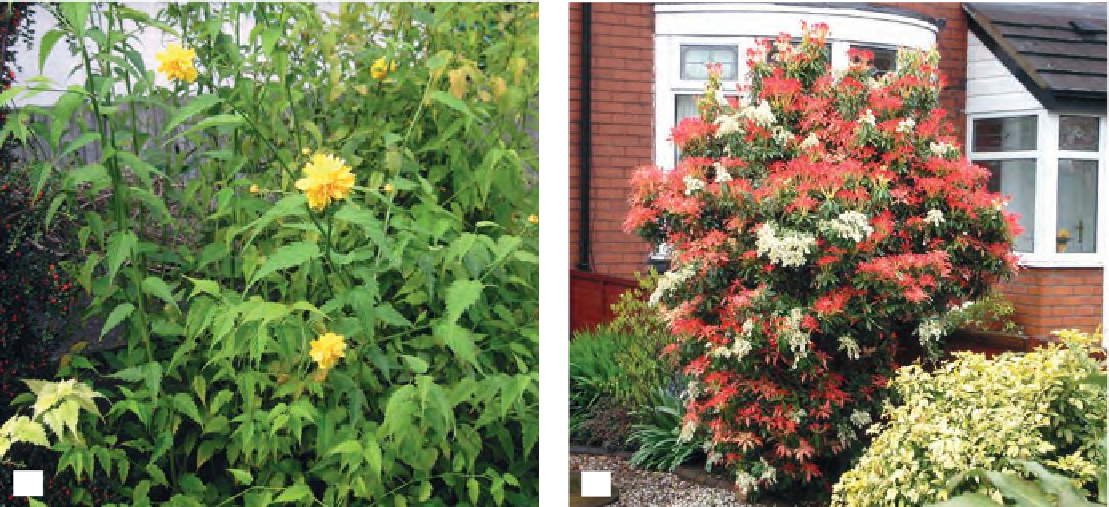Agriculture Reference
In-Depth Information
(a)
(b)
Figure 2.15
(a)
Kerria japonica
was collected by William Kerr in Japan; (b)
Pieris japonica
John Fraser
(1750-1811) was born in Inverness-shire
and came to London in 1770 as a draper where he
developed an interest in the Chelsea Physic Garden
and the Apothecary's Garden. During the next few
years, he became involved in plant collecting which
led in 1780 to the first of seven visits to North
American. At this time, Fraser began the development
of his large 'American Nursery' near Sloane Square,
London. On a subsequent USA visit in 1785 around
South Carolina, Fraser collected
Phlox stolonifera
and
Magnolia fraseri
. In 1789, a mountain trek in the
secluded Allegheny mountains of eastern USA led
to the discovery of
Rhododendron catawbiense
, an
important breeding source for new cultivars. In 1797,
Fraser established a brief link with the Russian royal
family, selling new and established species of plants.
Financial difficulties contributed to Fraser's early death
in 1811 at the age of 60. Species named after Fraser
include
Abies fraseri
and
Frasera
spp. (gentianworts).
William Kerr
was born in Hawick, Scotland (date of
birth unknown), and was a gardener at Kew Gardens
before becoming, with Joseph Banks' encouragement,
a plant collector in China for almost eight years. He
also visited Java and Philippines. He is noted for
sending the ultra hardy shrub
Kerria
japonica
, which
bears his name, to Kew Gardens. In addition, he was
involved in collecting nearly 250 plants new to Europe.
These include
Euonymus japonicus
,
Lilium lancifolium
,
Pieris japonica
,
Nandina domestica
,
Begonia grandis
and
Rosa banksiae
.
He died in Colombo, Ceylon in
1812, a short time after becoming the superintendent
of the nearby gardens on Slave Island.
David Douglas
(1799-1834) was a Scottish botanist,
born near Perth, the son of a stonemason. He worked
as a gardener in Scone Palace, Perthshire for seven
years. There followed a year at a college in Perth,
and a short time of employment in Fife. His move to
the Botanical Gardens of Glasgow University and the
contact with William Hooker (the Garden Director and
Professor of Botany) led to him being recommended to
the Royal Horticultural Society of London. He was sent,
in 1824, on an expedition to Northwest America, where
he identified more than nine newly recorded conifers
in this harsh high-altitude landscape (
Pseudotsuga
menziesii
,
Picea sitchensis
,
Pinus lambertiana
,
Pinus
monticola
,
Pinus ponderosa
,
Pinus contorta
,
Pinus
radiata
,
Abies grandis and Abies procera
). Most of these
species would become important large garden trees
and sources of timber in Britain and Ireland. In addition
to these trees, Douglas was able to collect shrubs
and herbaceous species such as
Ribes sanguineum
,
Gaultheria shallon
,
Lupinus nanus
,
Penstemon douglasii
and
Eschscholzia californica
. Altogether he introduced
about 240 species of plants to Britain and Ireland.
In 1830, Douglas visited Hawaii, and then Northwest
America for the second time. His second Hawaii visit
in 1833 resulted in his early death at 35 years of age.
He fell into a pit while climbing a local volcano. He was
buried in Hawaii.
William Lobb
(1809-1864) was born in Cornwall and
employed by an Exeter nursery (Veitch) that had
already been responsible for the introduction to
England of
Araucaria araucana
(the 'Monkey-Puzzle'
tree) from Chile. His brother, Thomas, was sent to

